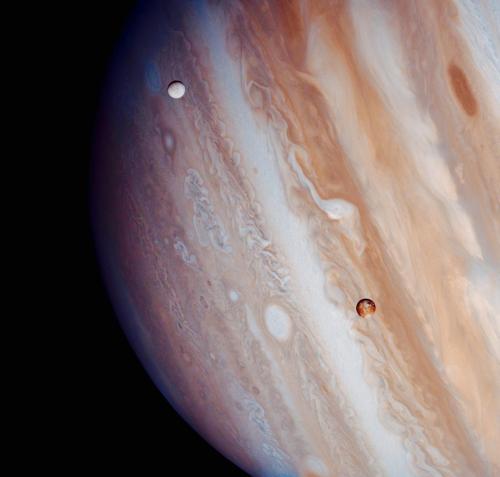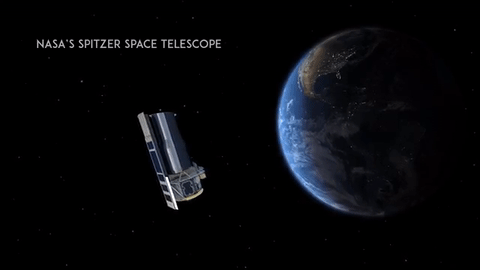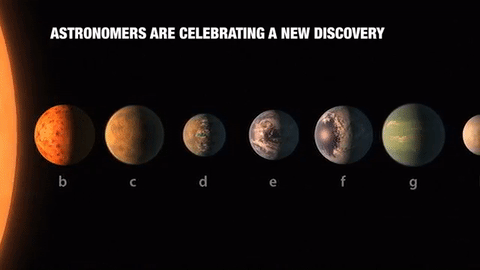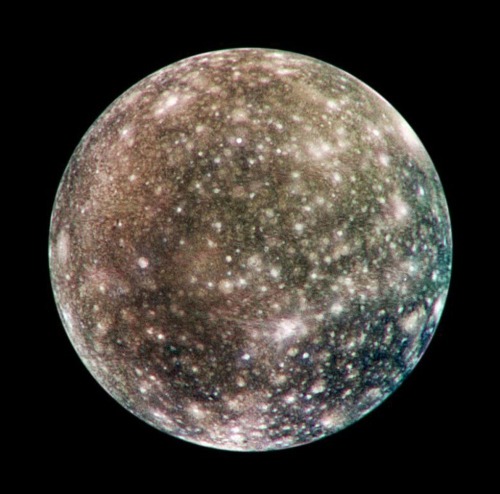Scenesofspace - Scenes Of Space

More Posts from Scenesofspace and Others

The surface of Jupiter imaged during a flyby from NASA’s Juno Spacecraft
theconstantbuzz:
Father and son oberve Apollo 11 Launch © Ralph Crane


Europa and Io over Jupiter.
Largest Batch of Earth-size, Habitable Zone Planets
Our Spitzer Space Telescope has revealed the first known system of seven Earth-size planets around a single star. Three of these planets are firmly located in an area called the habitable zone, where liquid water is most likely to exist on a rocky planet.

This exoplanet system is called TRAPPIST-1, named for The Transiting Planets and Planetesimals Small Telescope (TRAPPIST) in Chile. In May 2016, researchers using TRAPPIST announced they had discovered three planets in the system.

Assisted by several ground-based telescopes, Spitzer confirmed the existence of two of these planets and discovered five additional ones, increasing the number of known planets in the system to seven.

This is the FIRST time three terrestrial planets have been found in the habitable zone of a star, and this is the FIRST time we have been able to measure both the masses and the radius for habitable zone Earth-sized planets.
All of these seven planets could have liquid water, key to life as we know it, under the right atmospheric conditions, but the chances are highest with the three in the habitable zone.

At about 40 light-years (235 trillion miles) from Earth, the system of planets is relatively close to us, in the constellation Aquarius. Because they are located outside of our solar system, these planets are scientifically known as exoplanets. To clarify, exoplanets are planets outside our solar system that orbit a sun-like star.

In this animation, you can see the planets orbiting the star, with the green area representing the famous habitable zone, defined as the range of distance to the star for which an Earth-like planet is the most likely to harbor abundant liquid water on its surface. Planets e, f and g fall in the habitable zone of the star.
Using Spitzer data, the team precisely measured the sizes of the seven planets and developed first estimates of the masses of six of them. The mass of the seventh and farthest exoplanet has not yet been estimated.

For comparison…if our sun was the size of a basketball, the TRAPPIST-1 star would be the size of a golf ball.
Based on their densities, all of the TRAPPIST-1 planets are likely to be rocky. Further observations will not only help determine whether they are rich in water, but also possibly reveal whether any could have liquid water on their surfaces.
The sun at the center of this system is classified as an ultra-cool dwarf and is so cool that liquid water could survive on planets orbiting very close to it, closer than is possible on planets in our solar system. All seven of the TRAPPIST-1 planetary orbits are closer to their host star than Mercury is to our sun.

The planets also are very close to each other. How close? Well, if a person was standing on one of the planet’s surface, they could gaze up and potentially see geological features or clouds of neighboring worlds, which would sometimes appear larger than the moon in Earth’s sky.

The planets may also be tidally-locked to their star, which means the same side of the planet is always facing the star, therefore each side is either perpetual day or night. This could mean they have weather patterns totally unlike those on Earth, such as strong wind blowing from the day side to the night side, and extreme temperature changes.

Because most TRAPPIST-1 planets are likely to be rocky, and they are very close to one another, scientists view the Galilean moons of Jupiter – lo, Europa, Callisto, Ganymede – as good comparisons in our solar system. All of these moons are also tidally locked to Jupiter. The TRAPPIST-1 star is only slightly wider than Jupiter, yet much warmer.
How Did the Spitzer Space Telescope Detect this System?
Spitzer, an infrared telescope that trails Earth as it orbits the sun, was well-suited for studying TRAPPIST-1 because the star glows brightest in infrared light, whose wavelengths are longer than the eye can see. Spitzer is uniquely positioned in its orbit to observe enough crossing (aka transits) of the planets in front of the host star to reveal the complex architecture of the system.

Every time a planet passes by, or transits, a star, it blocks out some light. Spitzer measured the dips in light and based on how big the dip, you can determine the size of the planet. The timing of the transits tells you how long it takes for the planet to orbit the star.

The TRAPPIST-1 system provides one of the best opportunities in the next decade to study the atmospheres around Earth-size planets. Spitzer, Hubble and Kepler will help astronomers plan for follow-up studies using our upcoming James Webb Space Telescope, launching in 2018. With much greater sensitivity, Webb will be able to detect the chemical fingerprints of water, methane, oxygen, ozone and other components of a planet’s atmosphere.
At 40 light-years away, humans won’t be visiting this system in person anytime soon…that said…this poster can help us imagine what it would be like:

Make sure to follow us on Tumblr for your regular dose of space: http://nasa.tumblr.com
Actually, Mercury Is Our Closest Planetary Neighbor
If you look at the orbits of the planets adjacent to the Earth’s orbit (Venus & Mars), you’ll see that Venus’s orbit is closest to our own. That is, at its closest approach, Venus gets closer to Earth than any other planet. But what about the average distance?
According to this article in Physics Today by Tom Stockman, Gabriel Monroe, and Samuel Cordner, if you run a simulation and do a proper calculation, you’ll find that Mercury, and not Venus or Mars, is Earth’s closest neighbor on average (and spends more time as Earth’s closest neighbor than any other planet):
Although it feels intuitive that the average distance between every point on two concentric ellipses would be the difference in their radii, in reality that difference determines only the average distance of the ellipses’ closest points. Indeed, when Earth and Venus are at their closest approach, their separation is roughly 0.28 AU – no other planet gets nearer to Earth. But just as often, the two planets are at their most distant, when Venus is on the side of the Sun opposite Earth, 1.72 AU away. We can improve the flawed calculation by averaging the distances of closest and farthest approach (resulting in an average distance of 1 AU between Earth and Venus), but finding the true solution requires a bit more effort.
What the calculation also shows is that Mercury is the closest planetary neighbor to every planet, on average. Also, the authors of the paper don’t explicitly mention this, but the Sun (at 1 AU) is closer on average to the Earth than even Mercury (1.04 AU).



Three moons of Jupiter : Ganymede, Callisto and Io. Credits : NASA/JPL.

Earth from Afar
“It suddenly struck me that that tiny pea, pretty and blue, was the Earth. I put up my thumb and shut one eye, and my thumb blotted out the planet Earth. I didn’t feel like a giant. I felt very, very small.” - Neil Armstrong, Apollo 11

This week we’re celebrating Earth Day 2018 with some of our favorite images of Earth from afar…
At 7.2 million Miles…and 4 Billion Miles

Voyager famously captured two unique views of our homeworld from afar. One image, taken in 1977 from a distance of 7.3 million miles (11.7 million kilometers) (above), showed the full Earth and full Moon in a single frame for the first time in history. The second (below), taken in 1990 as part of a “family portrait of our solar system from 4 billion miles (6.4 billion kilometers), shows Earth as a tiny blue speck in a ray of sunlight.” This is the famous “Pale Blue Dot” image immortalized by Carl Sagan.

“This was our willingness to see the Earth as a one-pixel object in a far greater cosmos,” Sagan’s widow, Ann Druyan said of the image. “It’s that humility that science gives us. That weans us from our childhood need to be the center of things. And Voyager gave us that image of the Earth that is so heart tugging because you can’t look at that image and not think of how fragile, how fragile our world is. How much we have in common with everyone with whom we share it; our relationship, our relatedness, to everyone on this tiny pixel.“
A Bright Flashlight in a Dark Sea of Stars

Our Kepler mission captured Earth’s image as it slipped past at a distance of 94 million miles (151 million kilometers). The reflection was so extraordinarily bright that it created a saber-like saturation bleed across the instrument’s sensors, obscuring the neighboring Moon.
Hello and Goodbye

This beautiful shot of Earth as a dot beneath Saturn’s rings was taken in 2013 as thousands of humans on Earth waved at the exact moment the spacecraft pointed its cameras at our home world. Then, in 2017, Cassini caught this final view of Earth between Saturn’s rings as the spacecraft spiraled in for its Grand Finale at Saturn.
‘Simply Stunning’

”The image is simply stunning. The image of the Earth evokes the famous ‘Blue Marble’ image taken by astronaut Harrison Schmitt during Apollo 17…which also showed Africa prominently in the picture.“ -Noah Petro, Deputy Project Scientist for our Lunar Reconnaissance Orbiter mission.
Goodbye—for now—at 19,000 mph

As part of an engineering test, our OSIRIS-REx spacecraft captured this image of Earth and the Moon in January 2018 from a distance of 39.5 million miles (63.6 million kilometers). When the camera acquired the image, the spacecraft was moving away from our home planet at a speed of 19,000 miles per hour (8.5 kilometers per second). Earth is the largest, brightest spot in the center of the image, with the smaller, dimmer Moon appearing to the right. Several constellations are also visible in the surrounding space.
The View from Mars

A human observer with normal vision, standing on Mars, could easily see Earth and the Moon as two distinct, bright "evening stars.”
Moon Photobomb

“This image from the Deep Space Climate Observatory (DSCOVR) satellite captured a unique view of the Moon as it moved in front of the sunlit side of Earth in 2015. It provides a view of the far side of the Moon, which is never directly visible to us here on Earth. “I found this perspective profoundly moving and only through our satellite views could this have been shared.” - Michael Freilich, Director of our Earth Science Division.
Eight Days Out

Eight days after its final encounter with Earth—the second of two gravitational assists from Earth that helped boost the spacecraft to Jupiter—the Galileo spacecraft looked back and captured this remarkable view of our planet and its Moon. The image was taken from a distance of about 3.9 million miles (6.2 million kilometers).
A Slice of Life

Earth from about 393,000 miles (633,000 kilometers) away, as seen by the European Space Agency’s comet-bound Rosetta spacecraft during its third and final swingby of our home planet in 2009.
So Long Earth

The Mercury-bound MESSENGER spacecraft captured several stunning images of Earth during a gravity assist swingby of our home planet on Aug. 2, 2005.
Earth Science: Taking a Closer Look

Our home planet is a beautiful, dynamic place. Our view from Earth orbit sees a planet at change. Check out more images of our beautiful Earth here.
Join Our Earth Day Celebration!
We pioneer and supports an amazing range of advanced technologies and tools to help scientists and environmental specialists better understand and protect our home planet - from space lasers to virtual reality, small satellites and smartphone apps.
To celebrate Earth Day 2018, April 22, we are highlighting many of these innovative technologies and the amazing applications behind them.
Learn more about our Earth Day plans HERE.
Make sure to follow us on Tumblr for your regular dose of space: http://nasa.tumblr.com
The most mysterious star in the Milky Way
Astronomers are interested in the goings-on around a star in our galaxy called KIC 8462852. There appears to be a lot of debris around it, which is a bit unusual and might have any number of causes, including that an extraterrestrial intelligence built all sorts of things around the star.
Jason Wright, an astronomer from Penn State University, is set to publish an alternative interpretation of the light pattern. SETI researchers have long suggested that we might be able to detect distant extraterrestrial civilizations, by looking for enormous technological artifacts orbiting other stars. Wright and his co-authors say the unusual star’s light pattern is consistent with a “swarm of megastructures,” perhaps stellar-light collectors, technology designed to catch energy from the star.
“When [Boyajian] showed me the data, I was fascinated by how crazy it looked,” Wright told me. “Aliens should always be the very last hypothesis you consider, but this looked like something you would expect an alien civilization to build.”
Boyajian is now working with Wright and Andrew Siemion, the Director of the SETI Research Center at the University of California, Berkeley. The three of them are writing up a proposal. They want to point a massive radio dish at the unusual star, to see if it emits radio waves at frequencies associated with technological activity.
Phil Plait has more context on this weirdo star and how the alien angle is pretty far-fetched but also worth checking out.







NASA concept art from the Apollo era.
-
 badboy201804 liked this · 7 years ago
badboy201804 liked this · 7 years ago -
 fvtsshuttle reblogged this · 7 years ago
fvtsshuttle reblogged this · 7 years ago -
 retropopcult liked this · 8 years ago
retropopcult liked this · 8 years ago -
 ytomatoboi liked this · 8 years ago
ytomatoboi liked this · 8 years ago -
 madmichael reblogged this · 8 years ago
madmichael reblogged this · 8 years ago -
 captain-bannockburn reblogged this · 8 years ago
captain-bannockburn reblogged this · 8 years ago -
 scenesofspace reblogged this · 8 years ago
scenesofspace reblogged this · 8 years ago -
 topsecret9248 liked this · 8 years ago
topsecret9248 liked this · 8 years ago -
 gvike liked this · 8 years ago
gvike liked this · 8 years ago -
 jadedflyer liked this · 8 years ago
jadedflyer liked this · 8 years ago -
 sidhansonwhaat liked this · 8 years ago
sidhansonwhaat liked this · 8 years ago -
 captdf liked this · 8 years ago
captdf liked this · 8 years ago -
 fs-oyaji liked this · 8 years ago
fs-oyaji liked this · 8 years ago -
 tewi-22 liked this · 8 years ago
tewi-22 liked this · 8 years ago -
 rimfourati-blog liked this · 8 years ago
rimfourati-blog liked this · 8 years ago -
 hellolitten liked this · 8 years ago
hellolitten liked this · 8 years ago -
 nshrnr liked this · 8 years ago
nshrnr liked this · 8 years ago -
 ran4202 liked this · 8 years ago
ran4202 liked this · 8 years ago -
 takehara-no-mori liked this · 8 years ago
takehara-no-mori liked this · 8 years ago -
 t2tz liked this · 8 years ago
t2tz liked this · 8 years ago -
 747forever reblogged this · 8 years ago
747forever reblogged this · 8 years ago -
 crazydiscoturkey reblogged this · 8 years ago
crazydiscoturkey reblogged this · 8 years ago -
 mccrackenpaul liked this · 8 years ago
mccrackenpaul liked this · 8 years ago -
 me86 reblogged this · 8 years ago
me86 reblogged this · 8 years ago -
 tomsinterests reblogged this · 8 years ago
tomsinterests reblogged this · 8 years ago -
 omgplanoman reblogged this · 8 years ago
omgplanoman reblogged this · 8 years ago -
 darrinjoakley liked this · 8 years ago
darrinjoakley liked this · 8 years ago -
 gregador liked this · 8 years ago
gregador liked this · 8 years ago -
 poroussoul reblogged this · 8 years ago
poroussoul reblogged this · 8 years ago -
 poroussoul liked this · 8 years ago
poroussoul liked this · 8 years ago